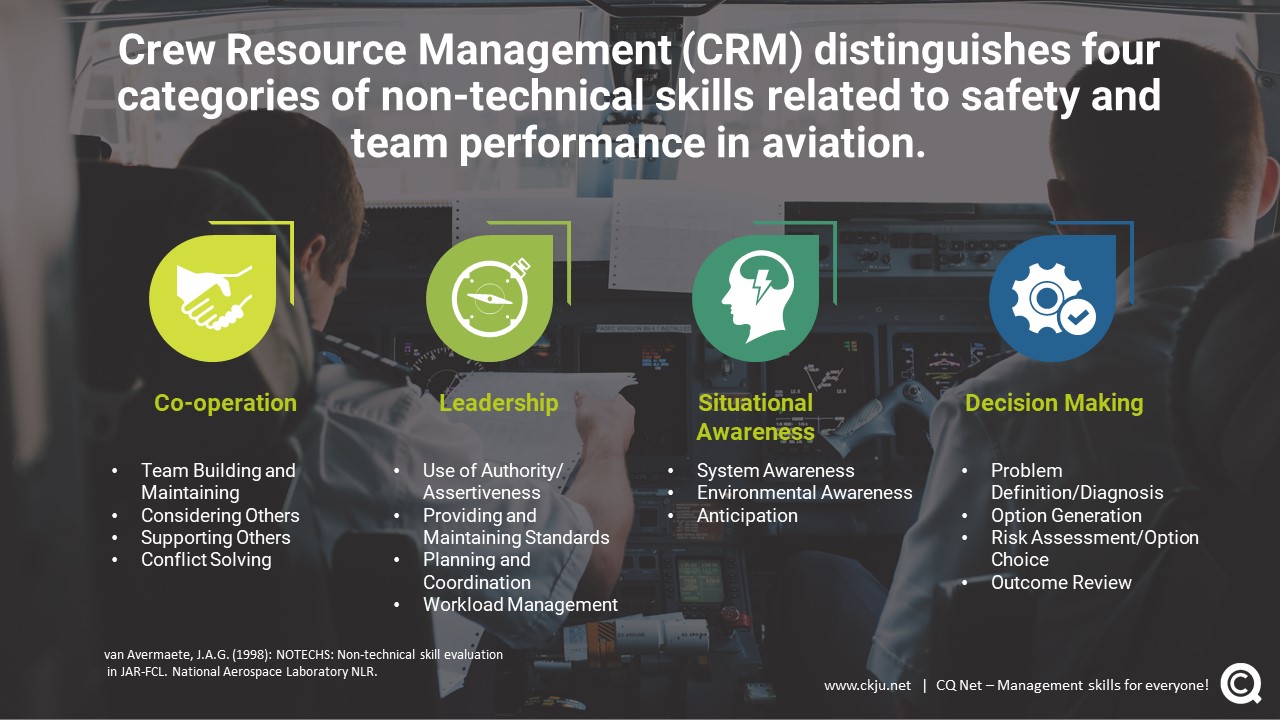- All Management Learning Resources
- Competencies and competency models

Executive summary
This CQ Dossier describes the foundation of competencies and competency models and how they can be used by professionals. In addition, we have a look at some practical examples of competency models used in different organisations and industries. Finally, we address the most important benefits and shortcomings of using competency models in organizations.
Contents
- Executive summary
- What are competencies? Competencies are a combination of knowledge, skills or abilities within a specific job context
- Competency models facilitate human resource practices
- How to design a competency model
- Competency models are best developed top-down
- Competency models in practice
- Competency models can be used as an organizational development intervention
- Shortcomings of competency models
- Key take-aways
- References and further reading
What are competencies? Competencies are a combination of knowledge, skills or abilities within a specific job context
Human resource management science recommends that to be competitive organizations should identify competencies necessary for successful job performance (Kesler, 1995). A competency is an individual’s demonstrated knowledge, skills or abilities also called KSAs that are demonstrated in a job context or particular organizational environment (Bozatzis, 1992).
In this way, competencies go beyond the traditional KSAs because they are demonstrated in a job context and the business environment dictates which specific KSAs need to be demonstrated (Wisher, 1994). In effect, competencies are combinations of KSAs allowing for a broader and deeper definition of what constitutes excellence within a work environment (Wisher, 1994).
Competency models facilitate human resource practices
There are core competencies that are required for all employees yet many are specific or vary in degree of concentration for that particular role or position. However, a holistic approach can be used to design a competency model for an organization that allows for grouping of employees into various categories. This holistic approach can then be used to design and develop various human resources procedures, such as training and development or performance appraisal systems, that allow organizations to predict which employees need or require skills training or are performing at a level that merits promotion (Montier, Alai & Kramer, 2006).
How to design a competency model
Organizations need to focus on what type of competency model is relevant to their work environment to design a complete model. Typically, a group of 7 to 9 total competencies are required for a particular job and depicted in a competency model (Shippman et al., 2000).
Competencies include a title, a definition and a description of the level of proficiency
When implementing a competency model, the competency tends to be more detailed than is typically seen in a traditional job analysis. Competencies are described quite thoroughly and include a title, a definition and a detailed description of the level of proficiency required for the competency (Campion et al., 2011).
Overall, it is best to aim for broadness over specificity as demonstrated by Boeing in their development of a competency model (Campion et al., 2011):
“During its competency modeling project, The Boeing Company recommended choosing only those competencies that would contribute to job and organizational performance, distinguished high performers, and would be directly used in management of employees (i.e., selection, promotion, retention, and development)”.
Observations, interviews and focus groups are used to develop competency models
Campion and colleagues also recommend a combination of methods to develop a competency model such as observations, subject matter expert (SME) interviews, and structured brainstorming methods in focus groups to identify core competencies (Campion et al., 2011). Utilizing a wide range of methods allows for a robust approach to developing a model that is appropriate for the organization.
Competency modeling supports talent and performance management efforts
There are several benefits for using competency modeling for human resource management purposes (Campion et al., 2011).
Competency modeling is a useful way for organizations to focus on the talent management within the organization; many times, executives ignore job analysis efforts so implementing competency modeling is a useful initiative to encourage them to pay more attention to competencies and how best to manage talent. Competency modeling allows organizations to distinguish top performers from average performers.
A focus on competencies allows for more focus on employees’ performance rather than a detailed description of tasks (Lievens, Sanchez & De Corte, 2004). Competency models also tend to be dynamic in that the analysis shows how competencies change based on the level within the organization or on the proficiency of the employee (Campion et al., 2011).
When designing and implementing a competency model the KSA can be linked to the business objectives within the strategic plan of the organization (Martone, 2003). This allows organizations to incorporate effective job analysis into their overall plan and to become competitive through strategic human resource management.
Competency models are best developed top-down
It is also important that organizations develop competency models from the top-down rather than bottom-up. When organizations start with executives rather than with line employees this facilitates change more rapidly because it adds legitimacy to the competency model. In addition, competency models may consider future job requirements to plan for future human resources needs. Competency models enable organization to invest more time in human resource management planning to ensure that there is top talent throughout all levels of the organization.
Communication is an integral component of designing and implementing a competency model within an organization. Therefore, it is important that senior executives present the model in a fashion that facilitates ease of use. For example, presentations can include organization-specific language or images that allow employees to easily recall the details of the model.
It is also important that organizations keep the competency model simple and easy to use through identifying a finite yet important number of competencies that can easily be identified and applied across a wide range of job functions.
Management skills newsletter
Join our monthly newsletter to receive management tips, tricks and insights directly into your inbox!
Competency models in practice
Competency models have become a widely used management tool in all sorts of organizations. In most cases organizations develop their own industry and context specific competency model. However, there are some examples of publicly available competency models we will briefly have a look at.
Aviation: Crew Resource Management non-technical skills (NOTECHS)
Inspired by private sector management training (Helmreich and Wilhelm 1991), the aviation industry started to conduct team development interventions already in 1979. Until then so-called Crew Resource Management (CRM) trainings for non-technical skills (NOTECHS) have become the de-facto industry standard in the aviation sector.
While the detailed breakdown of non-technical skills usually varies between different airlines, there is a set of four broad core NOTECHS categories (Avermaete 1998):
- Co-operation
- Leadership
- Situational Awareness
- Decision-making
Within each category there is a set of elements and assigned to each element there is a set of behaviors. The NOTECH framework is very similar to a competency model and is for instance used to assess a pilot’s or other crew members’ CRM skills (Flin et al., 2003).
Military: US Army core leader competency model
Leadership is an important performance factor in any organization. Leadership competency models open-up a wide range of possibilities to manage and develop leadership skills. One example is the US army core leader competency model (Horey et al., 2007). The model covers the following eight competencies (Horey et al., 2007):
- Lead others
- Lead by example
- Create a positive environment
- Communicate
- Develop leaders
- Prepare self to lead
- Get results
- Extend influence beyond chain of command
In a validation study Horey et al. (2007) confirmed the relationship of a high proficiency of the competencies with leadership performance. However, as with many competency models, they found a high level of inter-correlation between the competencies.
Career coaching: Which competencies make a good career coach?
Hatala and Hisey (2011) provide a nice example how to derive a competency model for career coaching based on a two way approach. First, they derived a framework of career coaching duties based on a literature review and interviews with HRD practitioners. In a second step they asked a set of career coaching practitioners whether they consider the identified competencies relevant or not (Hatala and Hisey, 2011). As a result, they derive the following eight career coaching competencies:
- Client exploration skills
- Organizational knowledge
- Career development knowledge
- Personal insight
- Task organizational skill
- Mental acuity
- Assessment skills
- Client network utility
Competency models can be used as an organizational development intervention
One of the other benefits of competency models are that they can be actively used to align human resource management systems. For example, competency models can be used within selection, employee training, performance management and promotion decisions as a method to evaluate, assess and provide feedback to employees at all levels. In fact, competency models can often be used as an organizational development interventions allowing organizations to introduce broad changes to HR systems.
Competency models can go beyond simple data collection efforts. Competency models can create a more robust hiring process too and research has supported that introducing competencies into hiring can enhance the process (Campion et al., 2011). Organizations tend to find the recruitment process is more stream-lined and consistent when they utilize competency models (Campion et al. 2011).
Shortcomings of competency models
As with any management tool, also competency models do have a set of shortcomings. We will have a look at some of the criticism related to competency models as follows.
Competency models overemphasize the “great individual”
Competency models put a strong emphasize on individual knowledge, skills, and abilities. Having in mind that contemporary organizations are complex systems, some critics argue that competency models over-emphasize a pre-defined set of KSA that cannot reflect the complexity required to succeed in a VUCA environment (Hollenbeck et al., 2006).
Competency models enable but also restrict professional development
Competency models represent a framework an organization uses to hire, assess, and develop people. One the one hand, looking through the lens of a competency model enables these activities. On the other hand, the competency model prevents the organization from looking at things from a different perspective. There is a risk that this “standardization effect” undermines diversity and prevents change (Bolden and Gosling, 2016).
Competency models do measure a single performance factor
Validation of competency models indicate a strong correlation with job performance. However, there seems to be also a strong inter-correlation between competencies (Horey et al., 2007; Society for Human Resource Management, 2011). This raises the question whether some of the competencies are necessary as they measure the same thing. This claim is also supported by findings of a single performance factor in job performance ratings (Viswesvaran et al., 2005).
In conclusion, a competency-based approach allows organizations to streamline and align their human resource practices. Organizations can adopt an organization-specific model that maps core competencies onto job relevant criteria. Adopting and implementing a competency model also energizes management into a focus on talent management and produces more effective performance.
Key take-aways
- Competencies allow for a broader and deeper definition of what constitutes excellence within a work environment
- Competency modeling allows organizations to distinguish top performers from average performers
- Competency models can be actively used to align human resource management systems
- Utilizing a wide range of methods allows for a robust approach to developing a competency model
- Examples of competency models include the non-technical skills (NOTECHs) in the aviation industry
- Validation studies indicate that competencies are related to performance outcomes
- Competency models do have shortcomings such as an overemphasize on the great individual
References and further reading
Bolden, R. and Gosling, J. (2016) ‘Leadership Competencies: time to change the tune // Leadership Competencies: Time to Change the Tune?’, Leadership, vol. 2, no. 2, pp. 147–163.
Boyatzis, R. E. (1982). The competent manager: A model for effective performance. New York: John Wiley & Sons.
Campion, M, A., Fink, A., A., Ruggeberg, B., J., Carr, L., Phillips, G., M., & Odman, R., B. (2011). Doing competencies well: Best practices in competency modeling. Personnel Psychology, 64, 225-262.
Flin, R., Martin, L., Goeters, K.-M., Hörmann, H.-J., Amalberti, R., Valot, C. and Nijhuis, H. (2003) ‘Development of the NOTECHS (non-technical skills) system for assessing pilots’ CRM skills’, Human Factors and Aerospace Safety, 3(2), pp. 95–117.
Hatala, J.-P. and Hisey, L. (2011) ‘Toward the development and validation of a career coach competency model’, Performance Improvement Quarterly, vol. 24, no. 3, pp. 101–122.
Horey, J., Harvey, J., Curtin, P., Keller-Glaze, H., Morath, R. and Fallesen, J. (2007) A Criterion-Related Validation Study of the Army Core Leader Competency Model Technical Report 1199.
Hollenbeck, G. P., McCall, M. W. and Silzer, R. F. (2006) ‘Leadership competency models’, The Leadership Quarterly, vol. 17, no. 4, pp. 398–413.
Lievens F, Sanchez J. I, De Corte W. (2004). Easing the inferential leap in competency modeling: The effects of task related information and subject matter expertise, Personnel Psychology, 57, 881-904.
Kesler, G. C. (1995). A model and process for redesigning the HRM role, competencies, and work in a major multi-national corporation. Human Resource Management, 34, 229-252.
Martone D. (2003). A guide to developing a competency-based performance-management system. Employment Relations Today, 30, 23–32.
Montier, R., Alai, D., & Kramer, D. (July, 2006). Competency models develop top performance. Training and Development. P. 47-49.
Shippmann, J.S., Ash, R.A., Battista, M., Carr, L., Eyde, L.D., Hesketh, B., Keyhoe, J., Pearlman, K., Prien, E.P., & Sanchez, J.I. (2000). The practice of competency modeling. Personnel Psychology, 53, 703-740.
Society for Human Resource Management (2011) Criterion Validation Study of the SHRM Competency Model.
van Avermaete, J.A.G. (1998): NOTECHS: Non-technical skill evaluation in JAR-FCL. National Aerospace Laboratory NLR.
Viswesvaran, C., Schmidt, F. L. and Ones, D. S. (2005) ‘Is there a general factor in ratings of job performance? A meta-analytic framework for disentangling substantive and error influences’, The Journal of applied psychology, vol. 90, no. 1, pp. 108–131.
Wisher, V. (1994). Competencies: The precious seeds of growth. Personnel Management, 26, 36-39.
About the Author

Related Dossiers






